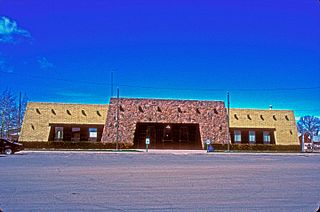
According to the 2011 census, the total population of the United Kingdom was around 63,182,000. It is the 21st-most populated country in the world. Its overall population density is 259 people per square kilometre, with England having a significantly higher population density than Wales, Scotland and Northern Ireland. Almost one-third of the population lives in England's southeast, which is predominantly urban and suburban, with about 9 million in the capital city of London, the population density of which is just over 5,200 per square kilometre.

Aitkin County is a county in the U.S. state of Minnesota. As of the 2010 United States Census, the population was 16,202. Its county seat is Aitkin. Part of the Mille Lacs Indian Reservation is in the county. The county was created in 1857 and organized in 1871.

Conejos County is one of the 64 counties of the U.S. state of Colorado. As of the 2010 census, the population was 8,256. The county seat is the unincorporated community of Conejos.

Camp Verde is a town in Yavapai County, Arizona, United States. As of the 2010 census, the population of the town is 10,873.

The demography of England has since 1801 been measured by the decennial national census, and is marked by centuries of population growth and urbanisation. Due to the lack of authoritative contemporary sources, estimates of the population of England for dates prior to the first census in 1801 vary considerably.
The United Kingdom Census 1901 was the 11th nationwide census conducted in the United Kingdom of Great Britain and Ireland, and was done on 1 April 1901 "relating to the persons returned as living at midnight on Sunday, March 31st".
The United Kingdom Census of 1841 recorded the occupants of every United Kingdom household on the night of 6 June 1841. The enactment of the Population Act 1840 meant a new procedure was adopted for taking the 1841 census. It was described as the "first modern census" as it was the first to record information about every member of the household, and administered as a single event, under central control, rather than being devolved to a local level. It formed the model for all subsequent UK censuses, although each went on to refine and expand the questions asked of householders.
A national census in Canada is conducted every five years by Statistics Canada. The census provides demographic and statistical data that is used to plan public services including health care, education, and transportation, determine federal transfer payments, and determine the number of Members of Parliament for each province and territory. At a sub-national level, two provinces and two territories have legislation that allows local governments to conduct their own municipal censuses.
Australians in the United Kingdom include Australians who have become residents or citizens of the United Kingdom. The largest segment of Australia's diaspora of 1 million resides in the United Kingdom.
Dutch people in the United Kingdom, also known as Anglo-Dutch people, include British people of Dutch ancestry and people born in the Netherlands who live in the United Kingdom. The 2001 UK Census recorded 40,438 Dutch-born people residing in the UK. More recent estimates by the Office for National Statistics put the figure at 56,000 in 2013. The 2011 Census recorded 57,439 Dutch-born residents in England, 1,642 in Wales, 4,117 in Scotland and 515 in Northern Ireland.
Lebanese people in the United Kingdom include people originating from Lebanon who have migrated to the United Kingdom and their descendants.
The United Kingdom Census of 1861 recorded the people residing in every household on the night of 7 April 1861, and was the third of the UK censuses to include details of household members. The census was taken and recorded everyone living in a household on Sunday 7 April 1861 The 1861 format of the census was identical to the previous 1851 census, despite pressures for 'religious affiliation' questions to be included. This suggestion was rejected at the time.
The United Kingdom Census of 1881 recorded the people residing in every household on the night of 3 April 1881, and was the fifth of the UK censuses to include details of household members.
Indonesian people in the United Kingdom includes British citizens and non-citizen immigrants and expatriates of Indonesian descent in the United Kingdom.
The United Kingdom Census 1911 of 2 April 1911 was the 12th nationwide census conducted in the United Kingdom of Great Britain and Ireland. The total population of the United Kingdom was approximately 45,221,000, with 36,070,000 recorded in England and Wales, 4,761,000 in Scotland, and 4,390,000 in Ireland.
The United Kingdom Census 1891 was a census of the United Kingdom of Great Britain and Ireland carried out on 5 April 1891. A question was added to record the number of rooms in a household, in response to concerns about overcrowding in cities. This was also the first census to employ women census takers and the first to ask in Wales about the ability to speak Welsh.







